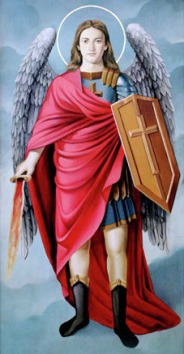 The honored Archangel, Michael, is the head of the hosts of heaven, who stands at all times before the great throne of God, interceding on behalf of the human race.
Joshua, the son of Nun, saw him in great glory and was frightened by him and fell on his face to the earth and said to him, "Are you for us, or for our adversaries?" So he said, "No; but as Commander of the army of the LORD I have now come ... I have given Jericho into your hand and its king." (Joshua 5:13-15, 6:2)
The Archangel Michael was with all the saints and martyrs. He strengthened them and enabled them to endure patiently until they finished their strife.
Festivals of commemoration are held and alms offered in his name on the twelfth day of each Coptic month. Our Coptic Orthodox Church celebrates two major feasts for Archangel Michael, namely on the 12th of Hator (November 21st) and on the 12th of Paona (June 19th).
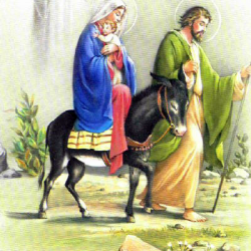 The Church celebrates the Feast of our Lord's Entry into Egypt on the 24th day of the month of Pashons (June 1st). This feast is among the Seven Minor Feasts of the Lord. As the Holy Family entered the land of Egypt, St. Mary the Virgin mother carried the child Jesus in her arms, with Joseph the Carpenter at her side and Salome, who accompanied them. They had done so in order to escape from Herod, who had sought to kill the Child. This was instructed to Joseph by the Archangel Gabriel in a dream where the Gabriel told him: "Get up, take the child and his mother, and flee to Egypt, and remain there until I tell you; for Herod is about to search for the child, to destroy him.' Then Joseph got up, took the child and his mother by night, and went to Egypt, and remained there until the death of Herod. This was to fulfill what had been spoken by the Lord through the prophet, 'Out of Egypt I have called my son" (Matthew 2:13-15).
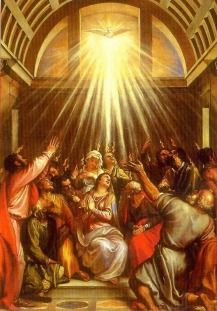 One of the Seven Major Feasts of the Lord is the descending of the Holy Spirit on the disciples, known as Pentecost Day (Fiftieth day). On this day, the Holy Spirit descended on the disciples as tongues of fire, through which they were able to speak in different tongues and preach the news entrusted to them by our Lord Jesus Christ. This gift is the promise of the Father to the human race. After the Son reconciled the Father with the human race by giving Himself up as a sacrifice on the Holy Cross, and after giving our human body the capability of living with God through His Ascension, God the Father poured on us the grace and blessings of the Holy Spirit, allowing us to live by the Spirit with God while we're still on earth. The feast is called "the Feast of Pentecost (Arabic: Ansara)," a Hebrew word that means, "feast." Originally this day was a Jewish feast, which was one of their three major feasts: the festival of weeks, the first fruits of wheat harvest, and the festival of ingathering at the turn of the year (cf. Ex. 34:22). On this day, the Jews thanked God for the ingathering, and they came from various countries around the world to Jerusalem for this feast (cf. Acts 2:5).
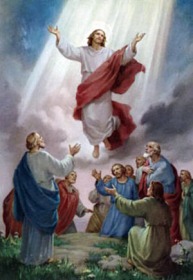 We celebrate two great feasts on Thursday. The first great feast of the Lord is Great Thursday of the Holy Pascha, on which the Lord gave us the Sacrament of the Holy Eucharist. The second is the Feast of the Ascension of our Lord into Heaven, after He spent forty days with His disciples. This Thursday is also a Feast of the Lord called the Feast of Ascension.
By the Ascension of the Lord, we mean His bodily Ascension.
Because in His divinity, He is everywhere, He does not ascend nor descend. Therefore, in the Liturgy of St. Gregory we say "And You ascended into the heavens in the body…" This ascension is evidence that His Glorified Body is not subject to the earth’s gravitational laws. It is also evidence of His Divinity. He ascended before His disciples as they were looking. This scene strengthened their faith because the Lord not only resurrected using His Divine power, but He also ascended into heaven in front of them.
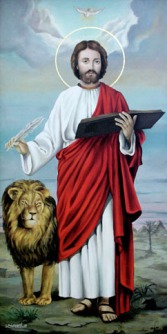 Saint Mark is considered to be the founder of the Coptic Orthodox Church. He is one of the Seventy Apostles appointed by our Lord (Mark 10:10), and one of the four Evangelists. He is regarded as the first of the unbroken chain of 117 patriarchs of the Coptic Church, and the first of a stream of Egyptian martyrs.
St. Mark was of Jewish descent, belonging to the tribe of Levi. He was born in Pentapolis (translated, the Five Western Cities) on the Northern coast of Africa, west of Egypt. His family lived in Cyrenica until they were attacked by barbarians at which time they moved to Jerusalem with their son, John Mark, John being Hebrew and Mark Roman. Evidently, he received a good education and, Hebrew being his native language, became fluent in both Greek and Latin. It is believed that St. Mark’s cousin was St. Barnabas, and his father’s cousin was St. Peter.
While St. Mark was traveling in Jordan with his atheist father, Arostalis, a lion and lioness appeared. His father begged St. Mark to escape at the cost of his own life, but St. Mark assured his father that Jesus Christ would save them both and began to pray. Suddenly, the two animals fell dead. As a result of that miracle, the father believed in Christ. For this reason, St. Mark is often portrayed with a lion.
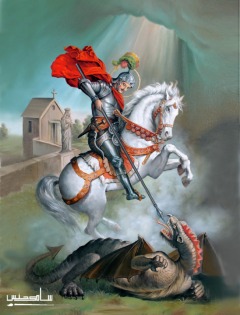 - St. George was born around 280 A.D. of a wealthy Christian family of noble origin in a the city of Capadocia in Asia Minor (a region of the ancient world that corresponds to modern day Turkey).
- St. George's father, Anastasios, was martyred for being a Christian by the Roman Governor when our saint was a young child. His mother Theopista raised him in a holy Christian manner.
- As a young nobleman, at the age of 17, St. George joined the Roman army where he fought many battles in Egypt and Palestine. He was quickly promoted by the governor to an officer in the Emperial Guard where he was commander over 1000 soldiers.
- St. George lost his mother when he was 20. From that time on, he abandoned the pleasures of this world, distributed his possessions among the poor, and set his slaves and maidservents free.
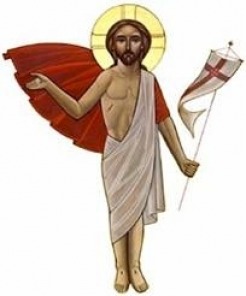 Joy in the Lord
The period of the Fifty Holy Days is a special period in the ecclesiastical cycle. The prominent feature of this period is joy. The Church prays with a festal tune in all Her liturgies and prayers, including the funerals. During this period, the Church lives the life of happiness, which was experienced by the holy disciples after Christ’s resurrection and His appearance to them. The Divine inspiration describes this joy as such, "Then the disciples were glad when they saw the Lord." (John 20:20) The Lord’s presence with the disciples led them to experience joy, which lasted with them for the rest of their lives. In the beginning, they saw the Lord with their eyes and touched Him, and they were happy. He continued to appear to them for forty days speaking to them about things pertaining to the Kingdom of God (Acts 1:3), until the time came for Him to leave them and ascend to heaven. However, after the forty days when Christ ceased to appear to them, the disciples’ happiness did not end.
"If then you were raised with Christ, seek those things which are above, where Christ is, sitting at the right hand of God." (Colossians 3:1)
My Beloved Brethren, Christ is Risen. He is Risen indeed.
On this glorious day, as we commemorate the blessed Resurrection of our Lord Jesus Christ, I would like to extend my hearty wishes to all of you praying to the Risen Lord to grant us His Resurrection and make it real in our life.
My beloved sons in the lands of immigration, priests and congregation.
Peace and grace from Our Lord, hoping that God may bless your lives and sanctify them and may every work that you do be successful. We thank God Who granted us to complete this Holy Pascha in peace and has brought us to the joys of His Resurrection. Our joy is not merely the joy of the Feast after ending the fast. Our joy however, is a spiritual joy, as the apostle said, "Rejoice in the Lord always. Again I will say, rejoice." (Philippians 4:4)
|







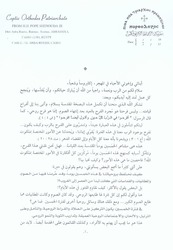
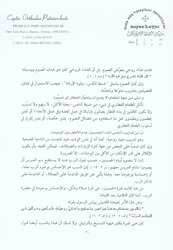
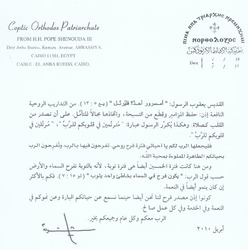
 RSS Feed
RSS Feed